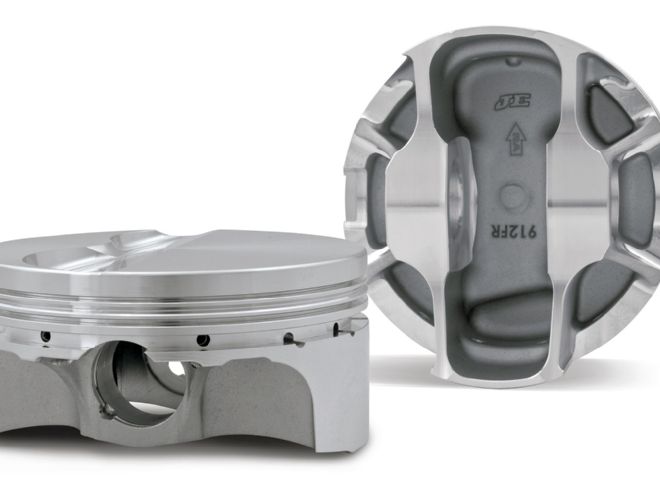
Pistons play the ultimate role in an engine, but despite that, it's still hard to fully wrap your head around all the forces involved. There are plenty of moving parts in an internal combustion engine, but just ponder for a moment the shear violence a piston has to endure. An engine is an explosion-driven air pump, and it's the pistons that have to endure the blast and convert it into meaningful kinetic energy. It's fairly simple to picture the process in slow motion, but try to think about it at 6,000 rpm, or under forced induction pressure.
It's easy to see that pistons are under an enormous amount of stress, which is why quality and design matter so much. If you look at a firing load scenario, which is a specific instance in time and crank angle when the cylinder pressure is at its peak, we have several forces acting upon the piston. The largest contributor is the cylinder pressure acting upon the piston crown and top ring groove, but the piston will also see additional loads exerted upon it due to the rod swing and rotation.
Known as the major and minor thrust faces, these are located on the side of the piston and are byproducts of the firing cycle. The load exerted on one piston skirt, referred to as the "major thrust side," (on the right side when viewing the engine from the flywheel end with the crankshaft rotating counterclockwise) can be up to 10 times higher than the load experienced by the opposing skirt, referred to as the "minor thrust side." The disparity in skirt loading varies in magnitude depending on key variables including the engine's stroke, rod length, and peak cylinder pressure.
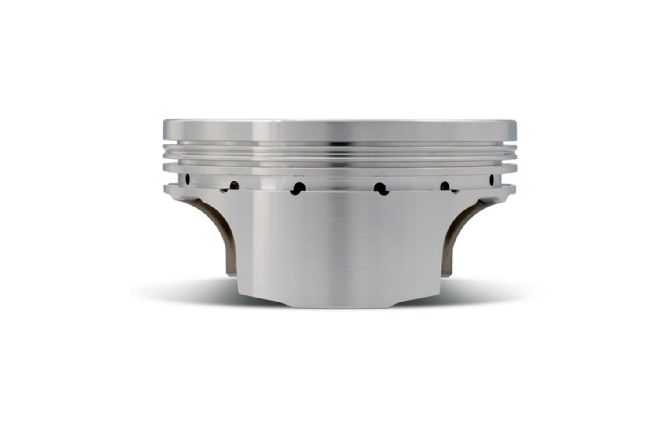 Here's a side view of the skirt on the major thrust side of an asymmetrical LS piston. Note its more standard skirt design.
Here's a side view of the skirt on the major thrust side of an asymmetrical LS piston. Note its more standard skirt design.
In a traditional design, a piston is symmetrical side to side, and the journal that holds the pin that joins the piston to the connecting rod is located in the center of the dome. That may have been the general rule, but when considering all the stresses involved it's almost never the ideal set-up. It just happens to be the easiest to design and manufacture and works acceptably well in most applications.
Acceptable design isn't what we want out of components for high horsepower engines at high rpm though. While uncommon at an off-the-shelf level, asymmetrical pistons and offset pins themselves aren't a new concept; they've been employed in race series like Formula 1, ALMS, and NASCAR for decades. Asymmetrical in this case means that the piston skirts do not mirror one another. Combined with a correctly offset piston pin, the design offers several benefits that can create more horsepower more reliably, and even translate into extra engine longevity. As such, automobile manufacturers have taken notice of the success of such designs in racing and recently began integrating asymmetrical piston designs and offset pins in some production engines. A great example is the LS7; the OEM piston is asymmetrical!
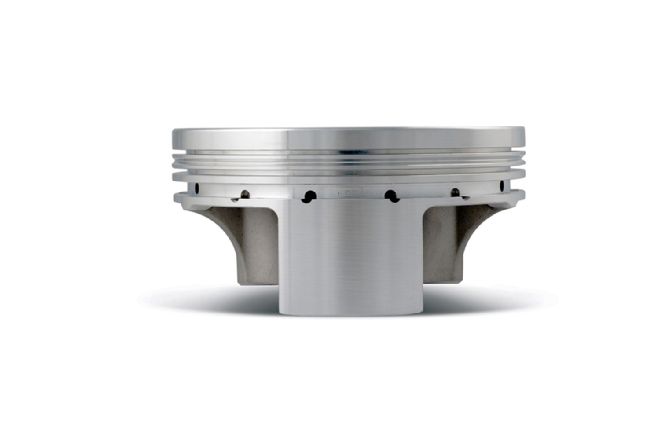 Compare that to the scalloped look of the minor thrust side. There's no need for the extra material here, so JE saves significant weight. This feature contributes to a weight savings around 60 grams per piston on average.
Compare that to the scalloped look of the minor thrust side. There's no need for the extra material here, so JE saves significant weight. This feature contributes to a weight savings around 60 grams per piston on average.
JE recognized there was a large technology gap in the aftermarket for hot rodders and lower-tier racers, especially in the high horsepower LS market. The power level in both naturally aspirated and forced induction that has become commonplace and expected in the LS community is well into the high hundreds, and even thousands of horsepower in blown cars. The main issue JE saw here is that nearly every aftermarket LS piston was still loosely based on older small-block Chevy designs.
Opting to go with a clean sheet approach, JE decided to create a piston that exhibited benefits for all levels of LS enthusiasts. We asked JE engineer Dane Kalinowski exactly what they were considering when deciding how to approach the new pin location and asymmetrical skirts.
"We began by looking at the market's expectation for power output in the high performance community. It became clear that the expectations for reliable power are very high among LS engine builders so we set out to create a design that could perform well in that environment," Kalinowski explained. "What we do is resolve the calculated loads into our defined coordinate system—since we're interested in the piston, the origin would be at the pin centerline—and sum them according to what load scenario we are looking at. We're creating a Free Body Diagram for the piston. As the crank rotates, the pin offset is in essence preloading the major skirt face, thus reducing noise caused by the piston bouncing back and forth between the walls. This preload does increase the stress levels of the piston on the major skirt face and struts as compared to a piston without pin offset and the same loads. The resulting piston features a large skirt area on the heavily loaded major thrust side and a small skirt area on the less loaded minor thrust side. The result is a piston design that is not only better equipped for the thrust loads, but is also stronger, yet lighter than previous designs."
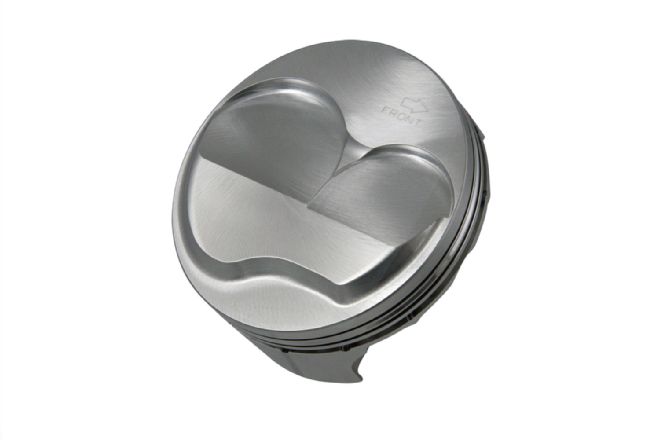 Based on feedback from numerous engine builders, JE has added the "Smooth Finish Crown" to all off-the-shelf asymmetrical pistons. This unique process blends all edges on the piston crown and valve reliefs, reducing the likelihood of hot spots and pre-ignition. Also, the ring pack will move to a thinner 1.2mm steel nitride upper, 1.5mm napier second, and 3mm oil ring.
Based on feedback from numerous engine builders, JE has added the "Smooth Finish Crown" to all off-the-shelf asymmetrical pistons. This unique process blends all edges on the piston crown and valve reliefs, reducing the likelihood of hot spots and pre-ignition. Also, the ring pack will move to a thinner 1.2mm steel nitride upper, 1.5mm napier second, and 3mm oil ring.
According to JE, these new LS asymmetrical pistons represent the beginning of a complete shift in their engineering philosophy towards such forgings that take all such parameters into account. In essence, what JE is working towards is creating an entire line-up of consumer level pistons that have the same degree of pro-level race engineering as the best funded teams, but that the average enthusiast can buy for his project. So far, JE has added 160 new part numbers to their line-up, and more are coming. JE was kind enough to supply CAD and FEA images of the LS asymmetrical pistons, so check out the captions and photos for a more visual representation of the theory and some additional benefits to JE's asymmetrical and offset pin design.
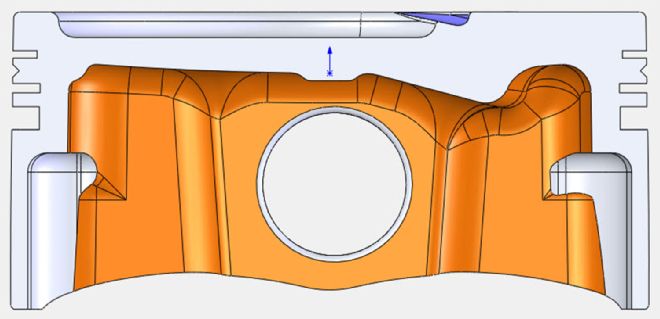 Just like each piston skirt, the piston crown is exposed to different mechanical and thermal loads in each area. The highest level of thermal (heat) and mechanical (pressure) stress is concentrated near the center of the piston crown. JE found the best way to handle these loads is to create a piston crown that is contoured according to these stress levels. In the location where stress is high (the center) the crown is thicker; in low stress areas the crown is much thinner. This design approach is one reason that JE's asymmetrical pistons are both strong and lightweight.
Just like each piston skirt, the piston crown is exposed to different mechanical and thermal loads in each area. The highest level of thermal (heat) and mechanical (pressure) stress is concentrated near the center of the piston crown. JE found the best way to handle these loads is to create a piston crown that is contoured according to these stress levels. In the location where stress is high (the center) the crown is thicker; in low stress areas the crown is much thinner. This design approach is one reason that JE's asymmetrical pistons are both strong and lightweight.
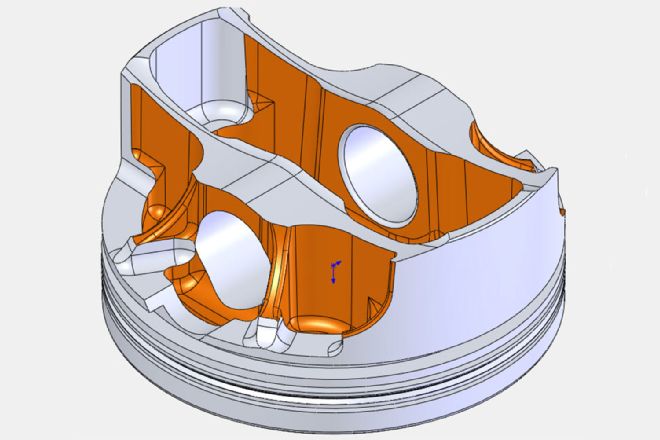 JE not only offsets the piston pin, they made it shorter. All JE asymmetrical pistons are designed to use a 2.250-inch wrist pin while most other designs require a 2.500-inch or even 2.750-inch pin. Since wrist pins are made of steel, a small reduction can make a large difference in overall weight. In most cases, the shorter wrist pin reduces weight by around 10 grams per cylinder while also reducing the potential of pin flex and breakage.
JE not only offsets the piston pin, they made it shorter. All JE asymmetrical pistons are designed to use a 2.250-inch wrist pin while most other designs require a 2.500-inch or even 2.750-inch pin. Since wrist pins are made of steel, a small reduction can make a large difference in overall weight. In most cases, the shorter wrist pin reduces weight by around 10 grams per cylinder while also reducing the potential of pin flex and breakage.
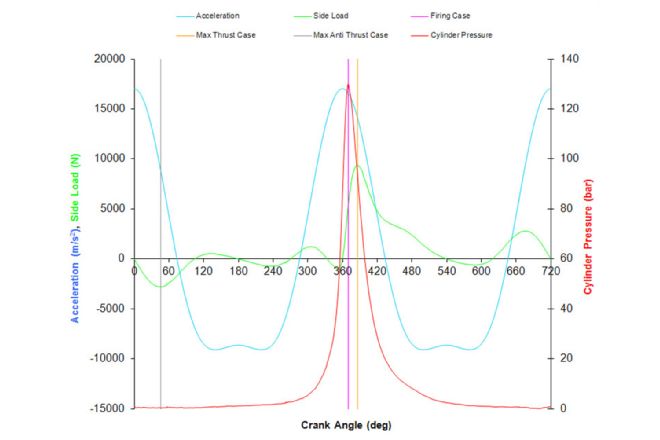 This is a graphic representation of the various loads experienced by an LS7 pistons referenced by degrees of crank angle. According to Kalinowski, "The pin offset has a minimal effect on the side load force that acts upon the piston and is primarily a function of engine geometry, cylinder pressure, crank angle, etc. So in the LS case, there is a fixed major thrust side load and fixed minor thrust side load acting upon the piston based on the calculations. The pin offset does affect the internal piston stress though as it is a structural change."
This is a graphic representation of the various loads experienced by an LS7 pistons referenced by degrees of crank angle. According to Kalinowski, "The pin offset has a minimal effect on the side load force that acts upon the piston and is primarily a function of engine geometry, cylinder pressure, crank angle, etc. So in the LS case, there is a fixed major thrust side load and fixed minor thrust side load acting upon the piston based on the calculations. The pin offset does affect the internal piston stress though as it is a structural change."
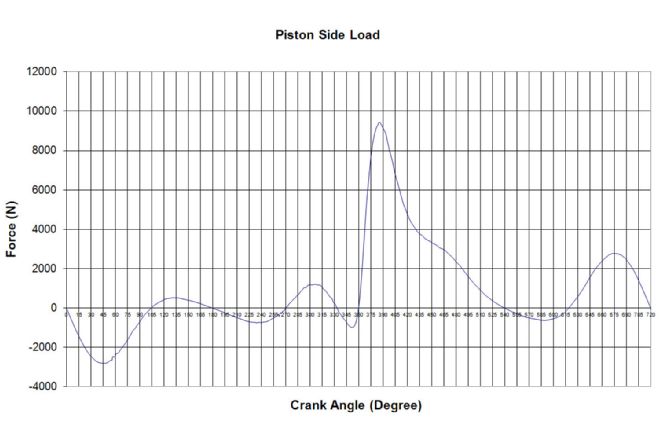 To optimize skirt profiles for race engines, JE ran tests based around very high cylinder pressure forced induction applications of more than 1,000 horsepower. For these LS pistons, they modeled a 4.100-inch stroke, 6.125-inch rod peak-firing-pressure scenario. Here we can see that major thrust load is close to 12,000N (Newtons) while the minor thrust load is barely 3,000N.
To optimize skirt profiles for race engines, JE ran tests based around very high cylinder pressure forced induction applications of more than 1,000 horsepower. For these LS pistons, they modeled a 4.100-inch stroke, 6.125-inch rod peak-firing-pressure scenario. Here we can see that major thrust load is close to 12,000N (Newtons) while the minor thrust load is barely 3,000N.
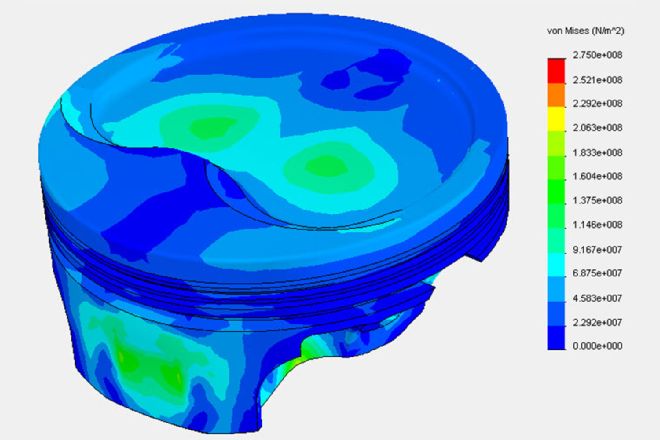 To optimize skirt profiles for race engines, JE ran tests based around very high cylinder pressure forced induction applications of more than 1,000 horsepower. For these LS pistons, they modeled a 4.100-inch stroke, 6.125-inch rod peak-firing-pressure scenario. Here we can see that major thrust load is close to 12,000N (Newtons) while the minor thrust load is barely 3,000N.
To optimize skirt profiles for race engines, JE ran tests based around very high cylinder pressure forced induction applications of more than 1,000 horsepower. For these LS pistons, they modeled a 4.100-inch stroke, 6.125-inch rod peak-firing-pressure scenario. Here we can see that major thrust load is close to 12,000N (Newtons) while the minor thrust load is barely 3,000N.
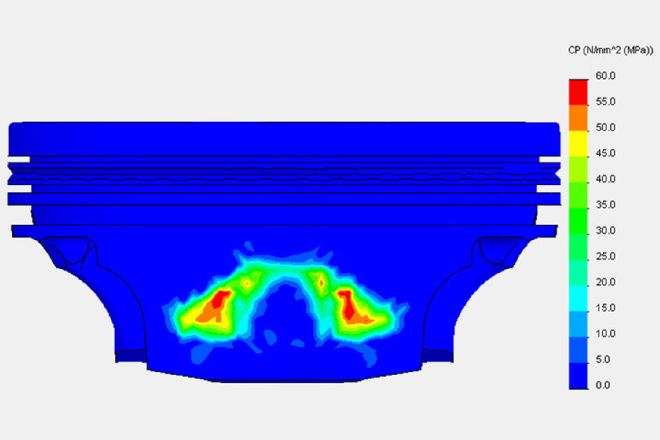 After several refinements, JE arrived at a final design that showed reduced stress, better heat management, and high horsepower tolerance. This FEA image shows stress on an asymmetrical LS LSX minor thrust face.
After several refinements, JE arrived at a final design that showed reduced stress, better heat management, and high horsepower tolerance. This FEA image shows stress on an asymmetrical LS LSX minor thrust face.
 JE ran prototypes of the new design in everything from 250hp turbo 4-cylinder street cars to 2,000hp turbo drag cars with success. Here we see the contact pressure on the major thrust face.
JE ran prototypes of the new design in everything from 250hp turbo 4-cylinder street cars to 2,000hp turbo drag cars with success. Here we see the contact pressure on the major thrust face.
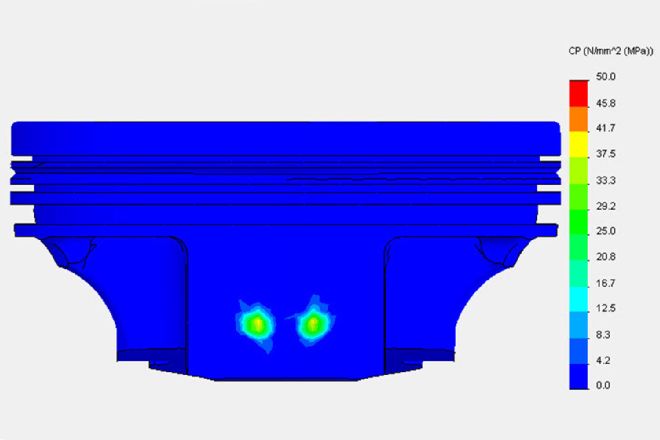 JE ran prototypes of the new design in everything from 250hp turbo 4-cylinder street cars to 2,000hp turbo drag cars with success. Here we see the contact pressure on the major thrust face.
JE ran prototypes of the new design in everything from 250hp turbo 4-cylinder street cars to 2,000hp turbo drag cars with success. Here we see the contact pressure on the major thrust face.